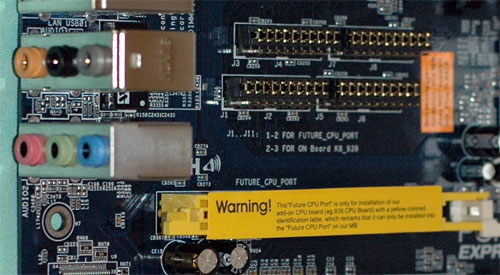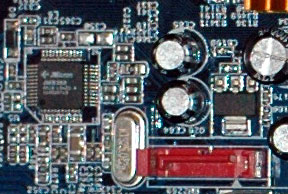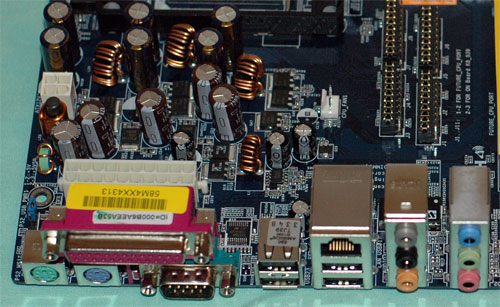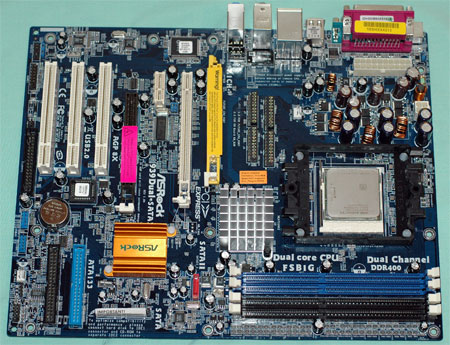ASRock 939Dual-SATA2: First Retail ULi PCIe/AGP
by Wesley Fink on September 7, 2005 12:05 AM EST- Posted in
- Motherboards
Board Layout: ASRock 939Dual-Sata2



The 20-pin (not 24-pin) ATX connector and 4-pin 12v connector are located between the CPU socket and the IO ports on this 3-phase board. This is not the most ideal location, but with both connectors near the board edge, it works well.

Value boards often present challenges in board layout to the end-user. Since the selling price is usually of foremost importance, the layout is often geared to efficient manufacturing more than end-user convenience.
The ASRock 939Dual-SATA2 is generally well laid out. Some thought clearly went into connector placement, but there are a few glaring oversights. The floppy and IDE connectors were hard to work with in a mid-tower case in light of their bottom right location. A standard IDE cable would barely make it from a top-mounted optical drive to IDE2. The floppy at the center bottom is particularly troublesome if you still use a floppy drive. If you don't, then it's a moot point.
You can clearly see the Asus heritage in the fact that ASRock uses only passive heatsinks on the 939Dual. Certainly, this is the best solution where noise is a concern, but it does not always provide for the most efficient cooling. Our experience during testing and overclocking the ASRock was that the Northbridge became pretty warm, but not warm enough to cause a shutdown or reboot.











56 Comments
View All Comments
poohbear - Thursday, January 19, 2006 - link
btw, this mobo does NOT support any cpu frequency above 274 w/ any of the official bios' (1.2 and after), so if u buy it thinking u can do 275x9 (or more) u wont. complained to ASRock about this but it falls on deaf ears. :(radiodad - Tuesday, December 6, 2005 - link
Interesting how posts end abruptly and not seeing any new posts on this board since September seems rather odd. Or is that normal? I just started researching my second build in 3+ years. That begs the questions of whether to buy this board, if anyone is still satisfied having bought one, and has this chipset held up? I want to multitask with a 64 X2 3800+ or 4000+ but if nobody is excited about this board anymore, then maybe I should go for the gusto and spend $200 on an Asus, but I rather not. Any comments?Krakn3Dfx - Saturday, December 17, 2005 - link
I picked up one about 2 weeks ago as a refurb from newegg. Worked great, I'm currently running an Opteron 146 on it @ 2.5GHz, you can learn a lot more about it over at ocworkbench.com, as they have a pretty extensive forums based on ASrock products. I still had some of the cold boot issues with the 1.2 bios, but upgraded to the 1.5 bios and they went away. Couldn't be happier with my $42 investment :).Wesley Fink - Friday, September 9, 2005 - link
ASRock has posted a 1.20 BIOS update at their website dated 9/02/05. We flashed an update to 1.2 and the Cold Boot problems have disappeared. If you are experiencing cold boot issues please update to BIOS 1.2. We will also add an update to the review.dlmetzger - Saturday, September 17, 2005 - link
What exactly is a 'cold boot' issue.The article stated "We did find extremely irritating cold boot issues with the ASRock in our testing. Even at standard stock speeds and settings, the 939Dual often required several starts to boot,"
I purchased the 939Dual for a new computer and it will not start when the power button is pushed. The pins on the System Power Header for the PWRBTN# to GND measure 3.37 Vdc.
Are these separate problems?
Fam Money - Monday, September 12, 2005 - link
Wesley, are you still able to achieve the same or better oc with the 1.20 BIOS? Which BIOS did you originally use?TIA
ElFenix - Friday, September 9, 2005 - link
does the new bios do anything else, like add more voltage adjustments?thanks!
ElJefe - Saturday, September 10, 2005 - link
I wish freakin dual core would drop to sane prices. the 4400 looks like the nice semi-future proofing system. This board is perfect for dual core from scratch setup, only good board out there that is garaunteed to work with dual core out of the box.Ocworkbench.com didnt experience cold boot problems. they use 1.20.
StillTickin - Thursday, September 8, 2005 - link
Hi,I'm planning to buy this board once it comes in stock again. I would of course eventually use PC3200 RAM or better on this board.
But I would like to know, in the interest of saving money for now, if my 512MB of PC2100 RAM that I have on my current motherboard (an FIC AD11) will work on this board for the time being.
Not a big deal if I have to buy new RAM right now, but it would help if that can wait a month or two, since I'm on a budget.
Thanks,
Aly
SynthDude2001 - Thursday, September 8, 2005 - link
I don't have any first-hand experience with A64 platforms (yet), but the PC2100 should be fine as long as you set the RAM speed to 133 instead of 200 (which I'm not entirely sure how to do on this board, you may have to get the details from someone else). I suppose it's possible that it might not boot because the default is 200, but it won't hurt to try.